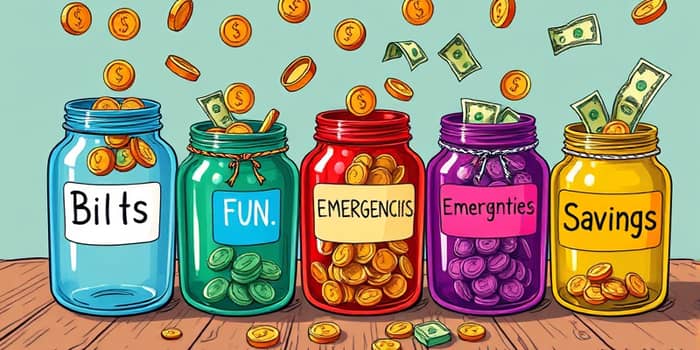Managing money can feel like walking a tightrope. One wrong step—overspending or neglecting savings—can tip you off balance. Income bucketting offers a structured, mindful approach to allocate funds and achieve your goals.
By dividing your earnings into dedicated buckets, you gain clarity and control over every dollar.
Understanding Income Bucketting
Income bucketting is a personal finance strategy where you allocate your income into separate categories or “buckets,” each serving a specific purpose. This method transforms vague budgeting into clear prioritization of your spending and saving efforts.
With buckets for necessities, splurges, emergencies, and goals, you can prevent overspending and strengthen discipline while still enjoying life.
Getting Started with Buckets
Implementing bucket budgeting requires planning, categorization, and consistency. Follow these foundational steps to set up your system.
- Identify Your Expenses: List all fixed and variable costs, such as rent, utilities, groceries, entertainment, and subscriptions.
- Group Expenses into Buckets: Common categories include necessities, fun money, emergency fund, and long-term savings.
- Decide on Allocation Percentages: Use frameworks like 50/30/20 or customize percentages based on your priorities.
- Set Up Physical or Digital Buckets: Open separate bank accounts or use budgeting apps to track funds.
- Automate Transfers to Each Bucket: Schedule automatic moves right after payday to maintain consistency.
- Monitor and Adjust: Review allocations monthly or quarterly to ensure they match evolving goals.
Designing Your Personal Buckets
Your buckets should reflect your lifestyle and financial objectives. Start with four to six core categories and refine over time.
This structure provides a foundation, but remember that allocations can change with life events. Adjust buckets when you receive a raise, face new expenses, or reach milestone goals.
Automation and Maintenance
One of the greatest advantages of bucket budgeting is the ability to automate transfers. By scheduling transactions on payday, you make saving and planning effortless.
Consider setting up automatic moves to accounts with limited access. This way, your emergency fund stays intact until you truly need it. Regularly review balances and spending trends to ensure each bucket remains on track.
Monitoring doesn’t have to be tedious. Use graphs and alerts in budgeting apps to track and visualize your progress at a glance.
Frameworks and Flexibility
- 50/30/20 Rule: 50% for needs, 30% for wants, 20% for savings and debt repayment.
- Three-Bucket Approach: Immediate expenses, medium-term goals, long-term savings.
- Four-Bucket Method: Fixed costs, fun money, emergency fund, savings goals.
These frameworks can serve as starting points. The key is to customize them to your circumstances—whether you earn a steady salary or face variable income.
Benefits and Long-Term Impact
Income bucketting offers several lasting advantages:
- Reduced Financial Stress: Knowing each dollar has a purpose brings peace of mind.
- Goal Visibility: Clear buckets make it easier to see progress toward travel, home purchase, or debt freedom.
- Disciplined Spending: Spending money earmarked for bills on a whim becomes nearly impossible.
Over time, this approach cultivates a mindset of intentional spending and consistent saving. You’ll find that disciplined habits compound into significant achievements, from building a robust emergency fund to enjoying that dream vacation.
Practical Tools and Tips
- Budgeting Apps: Use apps like YNAB or Mint to automate categorization and track balances.
- Spreadsheets: If you prefer manual control, create a dynamic spreadsheet with automatic formulas.
- Accountability Partners: Share your bucket plan with a friend or financial coach to stay motivated.
Remember, the number of buckets can evolve. Start simple and add complexity only if it helps you stay organized.
Conclusion
Balancing saving and spending doesn’t have to feel like an endless struggle. With income bucketting, you gain structure, flexibility, and a clear path toward your dreams. Whether you’re building an emergency cushion or saving for a once-in-a-lifetime trip, dedicating money to specific buckets ensures nothing gets overlooked.
Take the first step today: outline your expenses, set up buckets, and embrace a future of financial confidence.
References
- https://www.spaceship.com.au/learn/how-to-bucket-your-money/
- https://www.kiplinger.com/kiplinger-advisor-collective/bucket-budgeting-an-easy-way-to-manage-cash-flow
- https://theweek.com/personal-finance/best-budgeting-methods
- https://www.betterinvesting.org/learn-about-investing/investor-education/personal-finance/the-bucket-approach
- https://www.muddycolors.com/2024/03/freelance-finance-buckets/
- https://www.nerdwallet.com/article/finance/how-to-budget
- https://www.nab.com.au/personal/life-moments/manage-money/budget-saving/money-bucket
- https://www.investopedia.com/terms/f/financialperformance.asp










